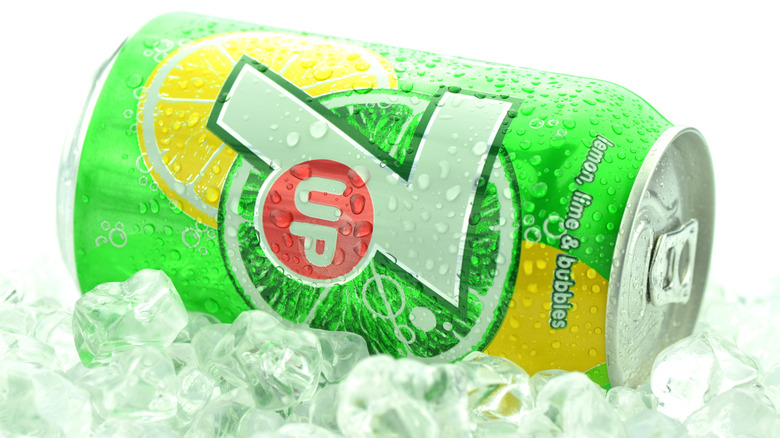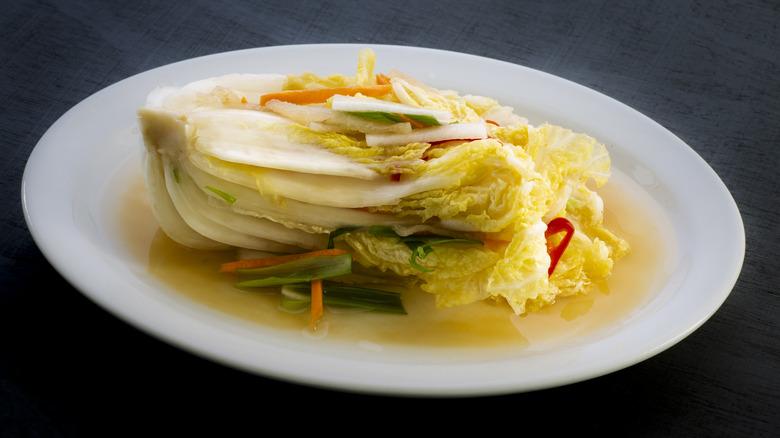David Chang's 7 Up Hack For Delicious White Kimchi
Kimchi is a cornerstone of Korean cuisine, but outside of the country it is woefully misunderstood. Most Americans probably think that "kimchi" refers to a single food –the classic napa cabbage kimchi made with fiery gochugaru chili flakes. This is actually called baechu kimchi, and as iconic as it is, it is only one member of a much larger family. Kimchi is actually a catch-all term for vegetables that have been salted and fermented, and you could technically make it from any vegetable you like.
Kimchi isn't necessarily spicy either, as some versions are made without gochugaru. These varieties are known as baek kimchi, which translates to "white kimchi". They serve as a refreshing way to beat the heat of a hot summer day or a spicy main course, and if you've only ever tried baechu kimchi, you'll find that its pale cousin is a whole different beast.
David Chang, the famed chef behind Momofuku and host of one of Netflix's best cooking shows, "Breakfast, Lunch, and Dinner," certainly knows a thing or two about kimchi, and his recipe for white kimchi includes an ingredient that might raise some eyebrows: 7 Up. It's a neat trick, and Chang isn't the only one to use it. It turns out that many Korean home cooks have been onto this hack for a long time.
Why so many cooks add soda to their kimchi
Obviously, American brand soda isn't a part of traditional baek kimchi, but it is inspired by the original method. Traditionally, kimchi is pickled and fermented for weeks, which causes profound chemical changes that ultimately define both its flavor and texture. Pickling and fermentation are different things, and while both are essential in traditional kimchi, when it comes to David Chang's 7 Up hack, it's the fermentation you need to know about.
During fermentation, the sugars and acids (7 Up has both!) that you add to the vegetable mix react with each other to form more acidic compounds, which is how kimchi gets its tanginess, but fermentation also creates another chemical: carbon dioxide. Just as carbonated beverages are fizzy, kimchi develops a sparkliness of its own. This is harder to notice in baechu kimchi, where the powerful spice dominates, but in white kimchi, the fizz really shines through.
Adding 7 Up to kimchi carbonates it in an instant, so you can get that signature fizz without going through the long fermentation period. It doesn't need to be 7 Up either. Chang offers Sprite as an alternative, and chef Esther Choi opts for Perrier's lime seltzer. You could also use ginger ale, but lemon and lime sodas are the more popular choice.
This hack works for multiple varieties of white kimchi
Baek kimchi is not a singular dish. It is a subcategory of kimchi, but just like kimchi writ large, there are multiple varieties. Most of these actually predate the better-known baechu kimchi, as chili peppers were not introduced to Korea until the 1500s. White kimchis are defined by their lack of gochugaru, giving more emphasis to the flavor of the vegetables. Additionally, most varieties of white kimchi have a distinct, fizzy texture, and the addition of 7 Up or other sodas can benefit these.
David Chang specifically uses 7 Up in mul kimchi, a type of white kimchi with a very distinct texture. Mul kimchi translates to "water kimchi," its name coming from the fact that this variety is fermented in a generous amount of liquid, making it essentially like a cold vegetable soup. The branches of the kimchi family tree extend even further, as there are subvarieties of mul kimchi. The most popular is dongchimi, which actually contains a small amount of gochugaru, though nothing close to the spice of baechu kimchi. Dongchimi traditionally includes radishes, which can become too soft if they ferment too long. Using a shortcut like adding some seltzer to the broth can speed things up, and save the crunchiness of those fresh vegetables.


